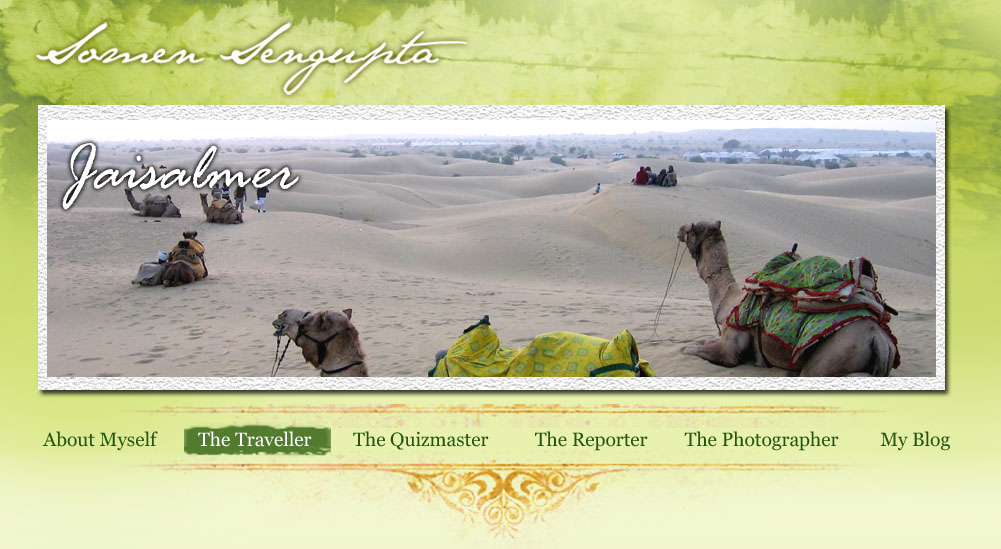| JAISALMER : GOLDEN KINGDOM OF SAND & STONE |
|
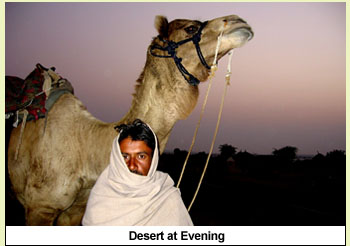 “Hello Mukul – how are you ? " “Hello Mukul – how are you ? "
This is the most common sentence by which a small kid, if he is a boy, is welcomed at every hotel reception of Jaisalmer, the desert city of Rajasthan.
Mukul - the child character in Satyajit Ray’s 1973
Bengali movie Sonar Qella has become a cult in Jaisalmer as the movie
was shot here for several months and after the release of it an almost
unknown town became one of the highest revenue earner for Rajasthan
tourism. The movie captured it’s historical edifices and harsh
geography in such a grand way that people from every corner of India,
and specially from Bengal could never ignore Jailsalmer if they were
touring Rajasthan. Almost overnight, from electricity to other civic
amenities, all were blessed to Jaisalmer, where till now a sizeable
population live inside of a 800 years old fort ! That is the magic of
a movie directed by a maverick maestro named Ray.
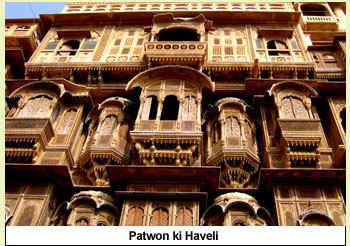 Whether Satyajit Ray
selected Jaisalmer or not for his movie, it was always an amazing
place. History contains a testimony of it’s glory. Whether Satyajit Ray
selected Jaisalmer or not for his movie, it was always an amazing
place. History contains a testimony of it’s glory.
Thanks to the glorious saga of Bhatti Rajputs and rich
traders of Marwar, the place bears a shining milestone
of human survival and intellectual expression under
the most harsh climate. Imagine a zone where no river
flows and depth of average sweet water well is 25 ft. The
sun in summer touches 50 degree with no plant on
ground and no cloud on sky to cover people and animal.
In this cruel desert, a race survived with it’s own archaeology
and craftsmanship for more than 800 years. No
doubt Jaisalmer is a signature of victory of human civilization.
Like all places of Rajasthan past of Jaisalmer is decorated
with glory of bravery and shadow of compromise.
Way back in 1156 the city was founded by one Bhatti
Rajput king named Raja Rawal Jaiwal and from him the
city got it’s name. The exact meaning of Jaisalmer is “hill
castle of Jaisal” that clearly indicates it’s existence as a
fort city. For long it remained safe from the Islamic
invaders mainly because of it’s tough access, but in
1294 when Bhatti Rajput looted caravans of booty of
Ala-ud-din-Khilji going to Sind, it was first attacked and
overtaken by muslims. Rajput girls observed “jauhar”
by jumping in fire to save themselves from the disgrace
of being looted at the hand of muslims. After that
Rajputs got back the hang of their own power and kept
peace with Mughals despite few fights with Humayun
and Sha-Jahan.
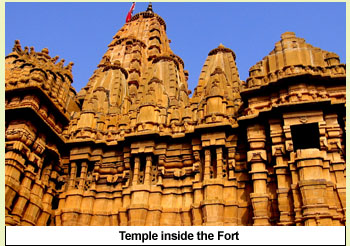 Needless to say, meanwhile the place was flush with
the taxes collected from the traders going to the spice
route, and that pushed this desert city towards the corner
of prosperity. A majestic fort, mind blowing havelies
and handicrafts were the outcome of this inflow of cash. Needless to say, meanwhile the place was flush with
the taxes collected from the traders going to the spice
route, and that pushed this desert city towards the corner
of prosperity. A majestic fort, mind blowing havelies
and handicrafts were the outcome of this inflow of cash.
Even now the city is identified with it’s 800 years old
fort, a UNESCO world heritage site.
The fort made of honey gold yellow sandstone is the
biggest land mark of Jaisalmer. This is a living fort where
still a half of the town’s population reside. The 800
years old fort houses 8 Jain and 4 Hindu temples, all
with superfine craftmanship on stone. Out of that,
Parswanath temple of 1417, Risavanath temple of
1479 and Shantinath temple also set up in 1479 are
mind blowing pieces of sand stone architecture. All
these temples are built in almost similar style of Dilwara
temple of Mount Abu. However these are much smaller
in sizes.
The wall of the fort runs 457 mt, 2nd longest in
Rajasthan after Chittore.
Once there were 99 watch towers ensuring a tight
security vigil of the place. Even now several towers and
gates stand here like old sentinels of a bygone era.
Ganesh pole is a plaza where people under death penalty
were executed, while at Bhutapol, Rajput women
used to sacrifice their lives in fire to protect their dignity.
Among the palaces Gaj vilas and Badal vilas also known
as tower of cloud are significant. Apart from that the
Rajmahal or the royal palace that dons the central plaza
of the walled fort is an outstanding piece of work.
Jaisalmer is often called the city of havelies. Havelies
are the giant palaces extensively decorated with sand
stone artwork and wall paintings. The arches, hanging
windows with cenotaph, cornish, pillars, balcony and
gates of havelies found here are so splendidly decorated
that often people are amazed as to how a suppressed
race living in this tough condition can express this level
of artistic talent in such a way !
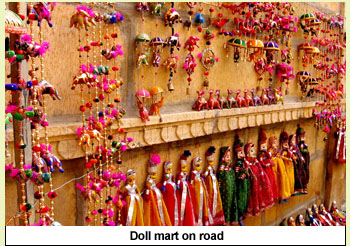 Among many such havelies the most famous and oldest
is Patwonji ki haveli constructed in 1805. This royal
residence built by a rich man named Guman Chand
Patwa, is a 5th storied building with many rooms and
huge open spaces. This haveli is basically an amalgamation
of 5 havelies meant for five sons of Guman Chand
who made his fortune in trading of gold and opium. This
is the most photographed haveli of Rajasthan. Thanks to
it’s proximity from the fort, it is always crowded with
tourists. The zafri that is floral designed carved out of
sandstone in this palace is just amazing. Among many such havelies the most famous and oldest
is Patwonji ki haveli constructed in 1805. This royal
residence built by a rich man named Guman Chand
Patwa, is a 5th storied building with many rooms and
huge open spaces. This haveli is basically an amalgamation
of 5 havelies meant for five sons of Guman Chand
who made his fortune in trading of gold and opium. This
is the most photographed haveli of Rajasthan. Thanks to
it’s proximity from the fort, it is always crowded with
tourists. The zafri that is floral designed carved out of
sandstone in this palace is just amazing.
Nathmalji ki havelie built in 1885 is considered as the
best specimen of desert architecture. Built as the residence
of powerful minister Diwan Mohota Nathmal, it
was designed by two architect brothers, namely Hathi
and Lulu. Their lack of coordination made a mess in the
completion of the haveli and that gives the palace an odd
look but this major weakness is forgotten in it’s eye
catching grand craftsmanship of stone. It’s elephant
gate and windows are worth watching. There are
plethora of paintings on the pillars and walls. Modern
tools and machine like car and fans which were
nowhere visible in Jailsalmer in those days were also
illustrated only by hearing description from other people.
Salim Singhji ki haveli which was residence of former
prime minister of the state and later bought by Meheta
family is one of the finest. Built in year 1815 this haveli
is a wonderful blending of Rajput and Islamic archaeology.
It has 38 balconies with blazing artwork on stone
and it looks like a ship. It was once taller than the royal
palace of the king and for that it was partly demolished.
In this desert city, a huge lake, actually a sweet water
reservoir built in 1367 is indeed an amazing find. The
Gadsisar lake planned by Maharwal Gadsi Singh the
ruler of this city in 14th century is a good example of
welfare state where water crisis of the people was
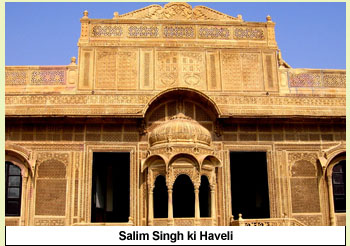 addressed in a modern way. The bank of this rain water lake was later crowded with various temples and palaces
which are still visible. This is a must visit place of
Jaisalmer along with a 5th floor tower namedTazia tower.
Stands at Badal mahal palace tower was built by a
muslim designer and it is a marvel of Islamic style. It is
nice to see how a Hindu kingdom allowed such an
archaeological harmony breaking common path of hostility.
16 kms from Jailsalmer one can find the ruins of
Lodurwa, the old capital of this kingdom. Another lake
Amar Sagar, known as the oasis of this desert, is also 6
km from the city. addressed in a modern way. The bank of this rain water lake was later crowded with various temples and palaces
which are still visible. This is a must visit place of
Jaisalmer along with a 5th floor tower namedTazia tower.
Stands at Badal mahal palace tower was built by a
muslim designer and it is a marvel of Islamic style. It is
nice to see how a Hindu kingdom allowed such an
archaeological harmony breaking common path of hostility.
16 kms from Jailsalmer one can find the ruins of
Lodurwa, the old capital of this kingdom. Another lake
Amar Sagar, known as the oasis of this desert, is also 6
km from the city.
The great Indian desert which was once brilliantly
captured by Satyajit Ray in his movie attracts people.
Thar the great Indian desert has 65% of it’s arid land
mass in Rajasthan. The sun baked land with limited
rainfall and least vegetation was once known as land of
death. More than 180 million years ago the place was
created when all its rivers dried up. Even now life is
tough under the cruel Sun.
The desert can be reached from Jalsalmer in a jeep
drive of 30 minutes and all kinds of amusement including
camel safari, jeep safari, desert music, dance and
food are available there. However the best part of this
desert is it’s harsh and ruthless face. It has it’s own craft
and own music which is distinctive and enriched. The
sand dunes here are thrilling and the golden sand bed at
twilight with a gray sky over it is just magical. After the
sundown the sky turns pink and the sand still glows. It
is the time when lamps are lit up in near by villages and
another day of survival comes to an end for the people
living here.
Travel Logistics:
Jaisalmer is well connected by railways from Delhi and Jaipur.
Regular buses are going to all over Rajasthan from here.
Nearest airport is Jodhpur which is 284 km away. Desert safari is done
from 4 pm - so be ready atleast an hour before.Your taxi or jeep will
pick you up from your hotel if contacted in advance. Jalsalmer fort is
a living fort and a home for hundreds of people - so please respect
their privacy.
Do not take photograph of private houses and people if not allowed.
Handcrafts are biggest attraction for shopping – do not miss colorful
Rajasthani canvas dolls – bargain hard.
Rajasthan Tourism is very helpful and has offices at many places.
Jaisalmer Govt Museum is a must visit place. Rajasthan tourism
organises desert festival in January - February.
Useful website: www.tourism.rajasthan.gov.in ■
This article was published in The Hitavada on 18th September 2016
Click here to view the original article
|
